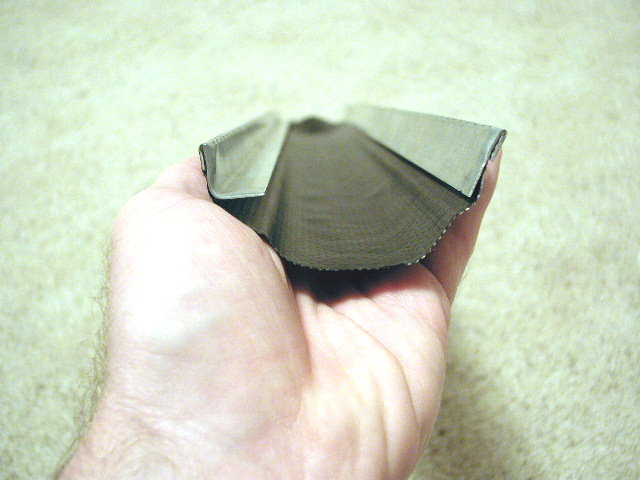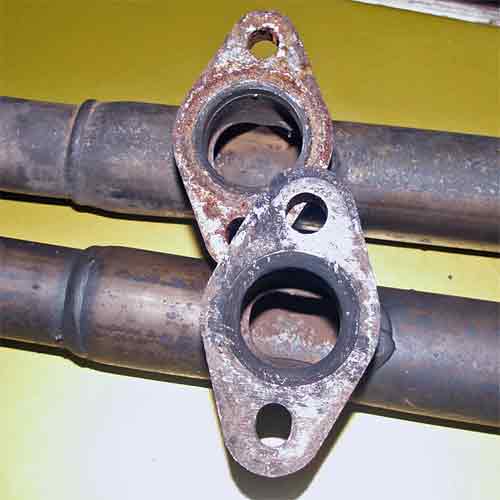 
     |
| 2.8L Exhaust Manifolds (Page 1/2) |

|
lyleap-gmc
|
AUG 01, 09:29 PM
|
|
Hi,
I have several cracks in the front exhaust manifold. I know they can be repaired, and at the same time the can be ported.
My question is are there any cast iron exhaust manifolds that can be used on the 2.8L?
Thanks to all,
Lyle
|
|

|
fierofool
|
AUG 01, 10:29 PM
|
|
|
3.1 and 3.4 manifolds will bolt to the heads, but they will not mate with the rest of the Fiero exhaust system.
|
|

|
pmbrunelle
|
AUG 02, 12:13 PM
|
|
You can say that the root cause of the manifold cracking problems is that the manifold seeks to expand with heat, but it is restrained from expanding from the rigid cylinder head.
The conflict between both parts is resolved with cracking...
I have bellows on my own car:
http://www.fiero.nl/forum/F...L/142133-3.html#p111
The intent of the bellows is to allow each part of the manifold to expand freely with the heat, stress-free (well, not completely free of stress, but far reduced).
Only a few thousand kilometres so far, so I cannot say that bellows are the final solution to 2.8 manifold problems, but so far things are looking good.[This message has been edited by pmbrunelle (edited 08-02-2020).]
|
|

|
fierofool
|
AUG 02, 07:26 PM
|
|
|
The odd thing is that the fro t and rear manifolds are almost identical and only the front one breaks. My theory has always been that the front one supports most of the weight and when support springs are missing too much weight is put on the front manifold.
|
|

|
pmbrunelle
|
AUG 02, 08:09 PM
|
|
I've only worked on Fieros in the "recent era", so after they've had recall work performed.
One difference between the front and rear manifolds is that one of them has elongated holes, while the other has smaller round holes. I don't remember which one was which.
There's also the dripping water factor; the instant cooling when a wet decklid is opened, pouring water on the front manifold.[This message has been edited by pmbrunelle (edited 08-02-2020).]
|
|

|
Patrick
|
AUG 02, 08:43 PM
|
|
| quote | Originally posted by pmbrunelle:
There's also the dripping water factor; the instant cooling when a wet decklid is opened, pouring water on the front manifold.
|
|
That's always been my suspicion as to why the front exhaust manifold is more prone to cracking than the rear one.
Even the original weatherstrip (removed as part of a recall) along the leading edge of the decklid was kind of useless, as water would still get dumped down on the front manifold if the decklid was opened when wet.
The best solution was/is this - read from Here (make sure to click the link in the first post) and continue on down to the bottom.
 [This message has been edited by Patrick (edited 08-02-2020).]
|
|

|
WKDFIRO
|
AUG 14, 10:59 PM
|
|
|
If the front transmission mount has failed the engine tries to pivot at that point. Which would explain why the front fails way before the rear does.
|
|

|
BillS
|
AUG 16, 01:00 PM
|
|
Aside from not fitting the rest of the system, the cast iron manifolds are heavier.
They did a fix on the 1988 Fieros - they ovalled the holes to allow room for expansion when they got hot.
This pic is a pair of manifolds I was using - the lower one shows the oval hole and the upper one has been machined out to give the up to 8 bhp boost that GM was too lazy/cheap to give you when they left the port half occluded by not milling the excess metal out. Takes about 5 seconds a hole with a set up machine or you can do it at home with a high speed grinder.

|
|

|
lyleap-gmc
|
AUG 16, 04:32 PM
|
|
| quote | Originally posted by fierofool:
The odd thing is that the fro t and rear manifolds are almost identical and only the front one breaks. My theory has always been that the front one supports most of the weight and when support springs are missing too much weight is put on the front manifold. |
|
fierofool, Where are the support springs supposed to be? Are you referring the the springs on the bolts that connect sections of the exhaust?
Thank you,
Lyle
|
|

|
Patrick
|
AUG 16, 05:25 PM
|
|
| quote | Originally posted by lyleap-gmc:
Are you referring the the springs on the bolts that connect sections of the exhaust?
|
|
I believe he's referring to the numerous springs that suspend the entire exhaust system.
|
|
    
  |















